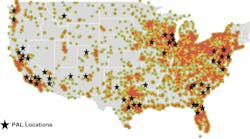Newly-renamed Hino Motors Sales USA has unveiled a new line of conventional medium-duty Class 4-7 straight trucks that will eventually replace its cabover model line here in the U.S.
There are six truck models in Hino's new conventional line, ranging from 14,050- 33,000-lb. GVW. All will be equipped with Hino's J-Series 5L or 8L engine model, offering between 175 and 260 hp. The trucks will be built in Japan and are expected to be available for sale starting in January 2004.
By the end of next year, however, Hino expects to move production to a plant in Long Beach, CA, owned by Toyota, which has a controlling interest in the company.
Vice president Derek Kaufman explained that Hino's reason for moving from building cabovers to conventionals in the North American market was fairly straightforward. “Hino has been in the U.S. market since 1984 and we have about 1% share of the medium-duty market,” he said. “With this new design, we believe we can grow our share dramatically.
FLEET OWNER had the opportunity to talk with Hisanobu Fujita, architect of the new conventional line and chief engineer of Hino Motors Ltd., parent company of Hino Motor Sales USA. Fujita pointed out that stricter emission rules are posing greater engine design and development challenges for medium-duty truck OEMs.
“Every two to three years we have new emission rules,” he said through an interpreter. “And as emission rules keep changing, it makes design issues so much more difficult, especially in terms of increased fuel consumption. Not only must we meet the new rules but we must also not lose on quality.”
“Trucks must be easier to drive and work in,” he added. “That means we still must focus on increasing truck cab space, providing better power steering, and other features. We still have to keep the truck quality very high in spite of changes caused by emission rules.”
300


